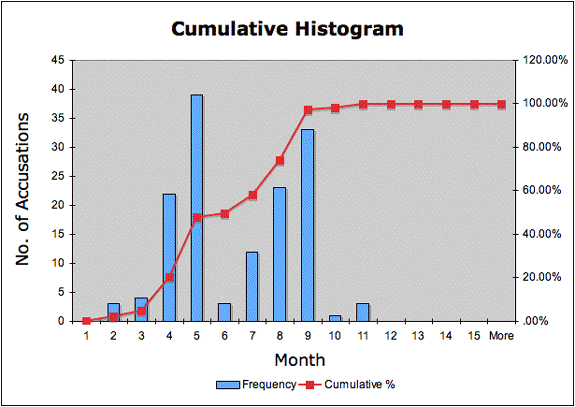Cumulative Histogram
| Bin | Frequency | Cumulative % |
| 1 | 0 | .00% |
| 2 | 3 | 2.10% |
| 3 | 4 | 4.90% |
| 4 | 22 | 20.28% |
| 5 | 39 | 47.55% |
| 6 | 3 | 49.65% |
| 7 | 12 | 58.04% |
| 8 | 23 | 74.13% |
| 9 | 33 | 97.20% |
| 10 | 1 | 97.90% |
| 11 | 3 | 100.00% |
A cumulative histogram counts the cumulative cases over the range of cases; using the Salem data, it tells what percentage of the total number of cases accumulated each month and, therefore, how much of the outbreak had taken place.
To construct a cumulative histogram, modifications should be made to the Accused Histogram Data Set to eliminate unknown cases (-1); only cases in which the months of accusation are known provide an accurate count of cumulated cases. In Excel, select the "Month of Accusation" column, go to the Data Menu and select "Filter" and then "AutoFilter." Click the resulting AutoFilter button in the column heading and choose "Sort Ascending." Proceed to the Tools Menu to select "Data Analysis" and "Histogram." For the "Input range," select the cells in the "Month of Accusation" column beginning with "2." For the "Bin range," exclude "-1" and select from the "Bin" column only case beginning with "1." Do not select "Labels." Select "New worksheet ply," "Cumulative percentage," and "Chart output."

The cumulative histogram and chart show the progression of accusations. Almost half, 48%, of the outbreak's accusations (whose dates are known) occurred between the end of February and the end of May. The second surge of accusations, beginning in July, accounted for 50% of the accusation, indicating that the outbreak was divided into two relatively equal segments. The histogram also dramatizes the importance of the month of October as the turning point of accusations. By the end of September 1692, fully 97% of the accusations had occurred, thereby directing attention to events in that period that would explain the outbreak's dramatic subsidence.
To return to the Accusation Discussion screen, click Back or Next.